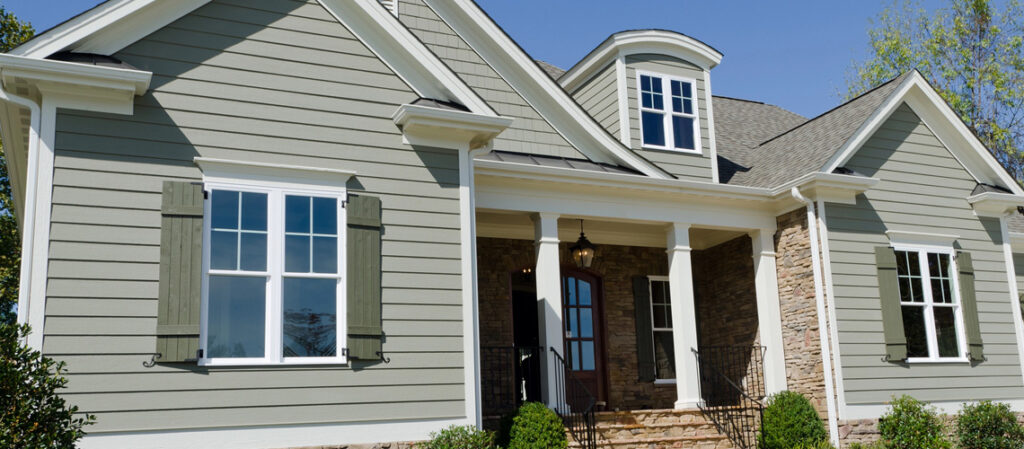Vinyl vs. Fiber Cement: Which Siding Is Right for Your Home? 
Choosing the right siding for your home is a significant decision that affects curb appeal, maintenance costs, and long-term value. Two of the most popular options on the market are vinyl and fiber cement siding. Both offer distinct advantages, but which one is the best fit for your needs?
This guide breaks down the key differences between vinyl and fiber cement siding across durability, maintenance, aesthetics, cost, and environmental impact. By the end, you’ll have the clarity you need to make a confident choice.
Durability: Which Siding Lasts Longer?
When it comes to durability, fiber cement siding takes the lead. Typically made from cement, sand, and cellulose fibers, fiber cement can last 50 years or more with proper care. It’s highly resistant to extreme weather conditions, including heavy rain, wind, and hail. It won’t crack, warp, or rot like wood, and it’s non-combustible, making it an excellent choice for fire-prone areas.
Vinyl siding, on the other hand, generally lasts 20 to 40 years. While it’s resistant to moisture and won’t rot, it can become brittle in freezing temperatures and may crack under impact. In areas with intense sun exposure, vinyl can also fade over time. That said, modern vinyl products have improved significantly, with some offering enhanced impact resistance and UV protection.
Winner: Fiber cement for longevity and toughness.
Maintenance: How Much Upkeep Is Required?
Vinyl siding is the clear winner when it comes to low maintenance. It doesn’t need to be painted, and cleaning is as simple as hosing it down or using a mild detergent. There’s no risk of peeling, chipping, or rotting, which makes it a hassle-free option for busy homeowners.
Fiber cement requires more attention. While it’s incredibly durable, it needs to be repainted every 10 to 15 years to maintain its appearance and protection. Fortunately, it holds paint exceptionally well, so when you do repaint, the results are long-lasting. Regular inspections for cracks or damage are also recommended, especially in harsh climates.
Winner: Vinyl for ease of maintenance.
Aesthetics: Which One Looks Better?
Both vinyl and fiber cement siding offer a range of design options, but fiber cement provides more versatility. It can be manufactured to mimic wood grain, shingles, or stucco with remarkable realism. Because it’s painted rather than dyed, you have virtually unlimited color choices. Fiber cement also tends to look more upscale and sophisticated, which can enhance your home’s overall appearance.
Vinyl siding has come a long way in terms of aesthetics. Modern vinyl can replicate the look of wood or stone fairly convincingly, and it’s available in a wide variety of colors and textures. However, because the color is part of the material itself, vinyl can fade over time, particularly in sunny climates. Touch-ups aren’t possible, so any fading is permanent.
Winner: Fiber cement for design flexibility and long-term color retention.
Cost: What’s the Investment? 
Vinyl siding is the more budget-friendly option upfront. Installation costs are lower, and the material itself is less expensive than fiber cement. For homeowners looking to keep initial costs down, vinyl is an attractive choice.
Fiber cement has a higher initial cost due to the material’s weight and the specialized installation it requires. However, its longevity and durability can make it a better long-term investment. When you factor in the potential for increased home value and fewer replacements over the years, fiber cement often delivers better overall value.
Winner: Vinyl for upfront affordability; fiber cement for long-term value.
Environmental Impact: Which Is Greener?
Fiber cement siding is generally considered the more eco-friendly option. It’s made from natural and recycled materials, and its long lifespan means less waste over time. Many manufacturers also produce fiber cement using sustainable practices.
Vinyl siding is a petroleum-based product, which raises environmental concerns. However, vinyl is recyclable, and some manufacturers offer recycled vinyl options. Its low maintenance requirements also mean fewer resources are needed over its lifetime.
Winner: Fiber cement for sustainability.
Click Here to Learn More About our Affordable Siding Services
Making Your Decision
Both vinyl and fiber cement siding have their strengths. Vinyl is ideal if you’re looking for an affordable, low-maintenance option that still offers solid performance. Fiber cement is the better choice if you prioritize durability, design flexibility, and long-term value.
Consider your budget, climate, and how long you plan to stay in your home. If you’re still unsure which siding is right for you, consult with a professional who can assess your specific needs and recommend the best solution.
Ready to upgrade your home’s exterior? Get a siding quote today and take the first step toward a more beautiful, protected home.
